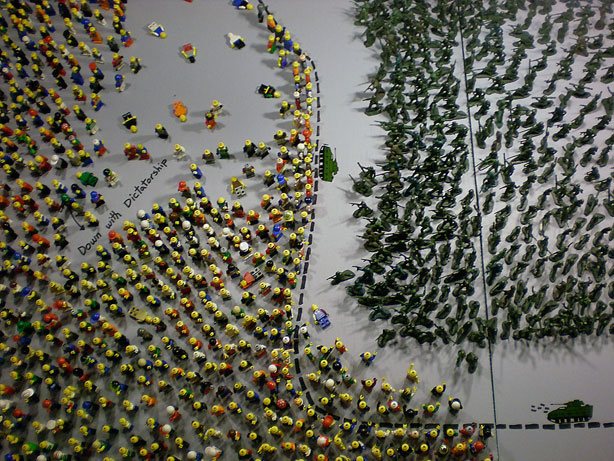At the exhibit’s entrance is wall, with a child-like drawing of a person, accompanied by a dictionary definition of the term ‘human being’. Next to this drawing is one of an owl; following, is an image of a box coloured in grey, which the accompanying caption tells us represents the colour ‘red,’ rendered in grey nuances. This theme characterizes the remaining drawings that form this introductory portion of Sayeh Sarfaraz’s exhibition at the Montréal, arts interculturels (M.A.I.): Étrange dictature.
While these initial images seem innocent and infantile, devoid of any overt political associations, the tone later changes when we see drawings labelled ‘democracy’, ‘military dictatorship’, and ‘political power’ all paired with short and concise definitions. Along the three other walls that make up Sarfaraz’s installation, forming an open cubic structure in the middle of the exhibition room, more drawings appear. These are coupled with with labels such as ‘human rights’, ‘Ayatollah’, ‘freedom of expression’, ‘prison’, and ‘video-surveillance’. Despite the seemingly unassuming medium of the simple, child-like drawings, the political nature of the exhibit gradually but surely unfolds: Sayeh Sarfaraz, who is of Iranian origin, has created a language allowing her to critically engage with the political system in her home country.
Her message reaches its climax with the centrepiece of the installation, which, much like the drawings, appears at first to be nothing more than the creative results of a child’s playful imagination: hundreds of miniature Lego-figures form a long queue, starting as a small, insignificant group at the top right-hand corner, and culminating in a mass-assembly in the bottom left. Upon closer inspection, however, it is no ordinary grouping of people. Confronting the small yellow Lego-figures are hundreds of soldiers: they point their weapons at the Lego-civilians from the other side of a military line of battle, as well as from the top of an archive-box at the fore of the installation, representing the central political power of the country. The numerous small drawers of the archive-box are labelled with the names of Iranian journalists and defenders of human rights, all of whom have at some point been subject to imprisonment by the political regime for exercising too freely their right to freedom of speech.
Formally known as the Islamic Republic of Iran, the state is presented by Sayeh Sarfaraz as an Islamic dictatorship: the Supreme Leader, accompanied by the President, has unrestricted powers, denying citizens their right to participate in a democratic political process, with freedom of expression as its most important founding element. Using seemingly apolitical and simple media to convey her message, she creates a language that is as universally accessible and accommodating, as the regime she portrays is obscure and uncompromising.
Étrange dictature runs from Jan. 19 to Feb. 16 at M.A.I. (Bureau 103, 3680 rue Jeanne-Mance). Admission is free.







